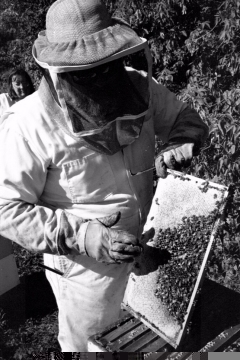

I've been
a beekeeper since I was 14 years old. Despite all appearances of
being a know-it-all, I'm still learning more about honey-bees. This
image is from my bee yard near North Branch, Minnesota. My wife,
Linda, can be seen in the background. She likes to equate the money
that I pour into the hives with the honey that I take out; I think she
knows that I don't know everything, but she politely does not bring that
up too often.
This summer (2000) I spent some time rearing
queens with some success. The small nucs were pleasant to work with,
seldom requiring any smoke. When I die of lung cancer I don't know
how weekly consumption of twine, burlap and sumac smoke will be explained....."Mr.
Leeper never could figure out how to be upwind from his smoker" or " Mr.
Leeper couldn't thought there was not connection between the black gunk
inside his smoker with black gunk inside his lungs." I guess that's
not so funny.
Anyway, the nucs were such a pleasure that I did
some research on wintering nucs in harse winter conditions. So for
the winter of 2000-2001 I'm going to winter a few nucs that I started in
late July. They're about three frames of bees and two of honey. I'm
going to package several in a fairly well insulated group, leaving adequate
top ventilation (the #1 winter problem in my experience) and planning on
feeding them in late January or early February with either new frames of
honey or heavy syrup.
Another interesting thing I learned this year was about the genetic origin of Africanized Honey Bees. Now this is going way back, but the Africanized bees evolved into a desert like environment that was characterized by drought, infrequent rain and short nectar flows. These bees have queens that lay more eggs, have a shorter maturation period, swarm multiple times, and very interestingly migrate frequently in excess of twenty miles. Our friendly Italian and Carniolan bees evolved in climates (think Fertile Crescent ) with regular seasonal rainfall ( and subsequent nectar flows) resulting in non-migrating colonies that swarmed once or maybe twice a year. Hence the northward migration of the Africanized bees from the infamous South American accidental release.